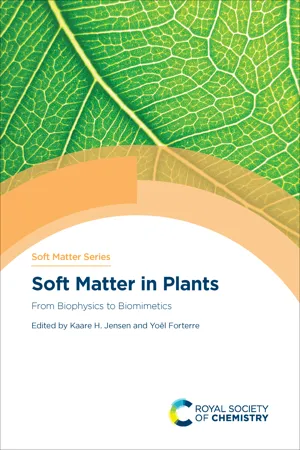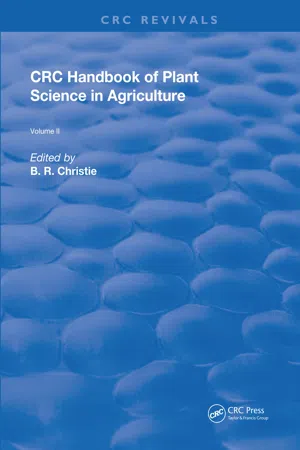Biological Sciences
Osmosis in Plants
Osmosis in plants refers to the movement of water through a semi-permeable membrane from an area of low solute concentration to an area of high solute concentration. This process is essential for maintaining turgor pressure in plant cells, which helps support the plant structure and facilitate nutrient uptake. Osmosis plays a crucial role in plant growth, development, and overall health.
Written by Perlego with AI-assistance
Related key terms
9 Key excerpts on "Osmosis in Plants"
- eBook - ePub
- Charles Adams, Mike Early, Jane Brook, Katherine Bamford(Authors)
- 2015(Publication Date)
- Routledge(Publisher)
Diffusion can occur with gases, e.g. oxygen and carbon dioxide exchange in the leaf, or water vapour in transpiration or with dissolved substances, e.g. movement of minerals in the soil. Osmosis The movement of water from a high water (low solute) concentration to a low water (high solute concentration) across a selectively permeable membrane. Solutes are substances dissolved in the water, e.g. sugars, ions. A selectively permeable membrane allows water to pass freely but excludes some solutes. The rate of osmosis depends on the concentration gradient of water across the membrane (the greater the difference in water concentration the faster the rate). Movement of water into and out of cells across the cell membrane, that is, in the symplast (p. 90 ). Mass flow (Bulk flow) The movement of water in response to a pressure gradient. The rate of flow depends on the pressure difference at each end of the system, the radius of the vessel, the distance travelled and the viscosity (thickness) of the liquid. Movement is fastest when the gradient is steep, the viscosity is low, the vessel is wide and the distance is short. The pressure which causes water to move is called hydrostatic pressure. Its values can be positive (a pushing pressure) or negative (a pulling or sucking pressure). Water movement: in the xylem (transpiration pull) (p. 91 ), in the phloem (mass flow) (p. 100 ) and between cells in the apoplast (p. 90 ). Active transport The uptake of a substance across a membrane against a concentration gradient. Active transport uses carrier proteins embedded in the membrane which move substances selectively across it. It is an energy requiring process. Uptake of mineral nutrients by cells (see p. 99 ).The solute concentration inside plant cells is largely regulated by the concentration of potassium ions (K+) in the cell vacuole hence the plant's requirement for potassium (see p. 170 ).Water is unusual
Water is one of the most common substances on Earth; it covers 70 per cent of the Earth's surface and is vital for all known forms of life. Pure water is tasteless, it does not conduct electricity (but conductivity increases with salt impurities, see salt concentration measurement p. 178 ) and it has a neutral pH (neither acid or basic) (see p. 178 ). Each water molecule contains two atoms of hydrogen and one atom of oxygen (see Basic chemistry p. 173 ), its chemical formula is therefore H2 - eBook - ePub
- Markus Keller(Author)
- 2020(Publication Date)
- Academic Press(Publisher)
In other words, cell membranes are not only capable of general filtration, but they are selectively permeable or semipermeable (Latin semi = half). Specialized gates consisting of transport proteins and ion channels are required for molecules other than H 2 O to pass through membranes (see Section 3.3). In the aqueous solutions of plants and soils water acts as a solvent for solutes, which include dissolved ions from dissociated inorganic and organic salts, and small uncharged organic molecules. The concentration of solutes inside a cell is almost always higher than the solute concentration of the exterior comprising the cell walls, intercellular space, and the space outside the plant body. Because the intracellular solutes are repelled by the pore openings in the cell membrane, their momentum drags water molecules away from the membrane along with the solutes, causing water to move passively through aquaporins and across the membrane into the cell (Kramer and Myers, 2013). This water movement is termed osmosis (Greek osmos = impulse, thrust). In other words, the presence of solutes in a cell exerts a “pull” or tension on the water molecules surrounding the cell. The greater the concentration of solutes, the more water will move into the cell to restore the hydraulic equilibrium. Osmotic pressure (π, expressed in MPa) of an aqueous solution is thus caused by dissolved solutes and increases linearly as the solute concentration (c, expressed in mol L −1 ; i.e., the number of dissolved molecules per unit volume) increases, and as the temperature (T) increases - eBook - ePub
Soft Matter in Plants
From Biophysics to Biomimetics
- Kaare Jensen, Yoël Forterre, Kaare Jensen, Yoël Forterre(Authors)
- 2022(Publication Date)
- Royal Society of Chemistry(Publisher)
Pressure-driven flows are very efficient in carrying water over long distances and are the main mode of water transport in the apoplast of plants (xylem, cell wall). Another important mode of transport in plants is osmosis, which occurs when solute concentration gradients exist across the semi-permeable membranes of living cells.1.1.3.1 Water Transport Across Cell Membranes
The transport of water and solute across a semi-permeable membrane like the plasma membrane of cells can be described using the framework of irreversible thermodynamics and the linear response between “forces” and “flux” (Onsager relations).35 ,47 ,77 ,148In the presence of a pressure difference ΔP and concentration difference Δc across the membrane, a volume flux (essentially water) J (unit m s−1 ) and a molar flux of solute j S (unit mol m−2 s−1 ) cross the membrane (Figure 1.4a ), given by5 :J = L p ΔP − L p σ S R T Δc ,1.111.12Figure 1.3 Measurements of the turgor pressure at cellular resolution. (a) Cellular pressure probe. (b) Nanoindentation (figure redrawn and adapted from ref. 93 ). Left: principle of the AFM technique. Center: small indentation depths δ give access to the cell wall elasticity. Right: large indentation depths are sensitive to both the local cell geometry, cell wall elasticity and turgor pressure.Figure 1.4 - eBook - ePub
The Science of Grapevines
Anatomy and Physiology
- Markus Keller(Author)
- 2015(Publication Date)
- Academic Press(Publisher)
Roelfsema and Hedrich, 2005 ).Figure 3.1 During diffusion, solutes (red) and water (blue) move in opposite directions, and the pressure remains constant (left). During osmosis, water moves toward the solutes across a semipermeable membrane (brown), increasing the pressure in the solute compartment (right).The solute and pressure forces in plants and soils are conveniently described as free energy per unit volume (i.e., equivalent to force per unit area, or pressure) that is generated by the random movement and collision of molecules. The free energy of water or, more accurately, of an aqueous solution, per unit molar volume of liquid water (~18 mL mol−1 ), is termed water potential (Ψ, expressed in J m−3 or as its pressure equivalent Pa=10−5 bar=N m−2 ) and is the sum of the component potentials arising from the effects of turgor pressure (i.e., turgor potential, ΨP =P ) and solutes (i.e., solute potential or osmotic potential, Ψπ =−π ) in addition to interactions with matrices of solids (e.g., cell walls) and macromolecules (i.e., matrix potential, ΨM ) and effects of gravity (i.e., gravitational potential, ΨG ), as described by the following equation (Boyer, 1969 - eBook - ePub
The Science of Grapevines
Anatomy and Physiology
- Markus Keller(Author)
- 2010(Publication Date)
- Academic Press(Publisher)
At this point, the cell’s internal hydrostatic pressure (more accurately, the pressure difference between inside and outside of the cell), termed turgor pressure (P) but often abbreviated as turgor (Latin turgere = to be swollen), is equal to the difference in osmotic pressure between the cell and its surroundings (i.e., P = π inside − π outside), and net water influx stops (Figure 3.1). Thus, osmotic pressure is defined as the hydrostatic pressure required to stop the net flow of water across a membrane separating solutions of differing concentration. In other words, osmosis can only work as a driving force for water flow (see Chapter 3.3) when two compartments are separated by a semipermeable membrane. Turgor pressure, in turn, is the osmotically maintained hydrostatic pressure inside living plant cells. The turgor pressure of growing cells typically reaches approximately 0.3–1 MPa—that is, 3–10 times atmospheric pressure (P a ≈ 0.1 MPa) (Cosgrove, 1997). Opening stomatal guard cells can generate over 4 MPa; nevertheless, the deformation of these cells and their cell walls is completely reversible (Franks and Farquhar, 2007; McQueen-Mason, 2005; Roelfsema and Hedrich, 2005). Figure 3.1 During diffusion, solutes (red) and water (blue) move in opposite directions (left), whereas during osmosis water moves across a semipermeable membrane (brown) to balance the water concentration deficit created by the solutes (right). The solute and pressure forces in plants and soils are conveniently described as free energy per unit volume (i.e., equivalent to force per unit area, or pressure) that is generated by the random movement and collision of molecules - eBook - ePub
- Andrew J. Baird, Robert L. Wilby, Andrew J. Baird, Robert L. Wilby(Authors)
- 2005(Publication Date)
- Routledge(Publisher)
2
WATER RELATIONS OF PLANTS
Melvin T. TyreeINTRODUCTION
Water relations of plants is a large and diverse subject. This chapter is confined to some basic concepts needed for a better understanding of the role of plants in eco-hydrology, and readers seeking more details should consult Slatyer (1967) and Kramer (1983).First and foremost, it must be recognised that water movement in plants is purely passive’. In contrast, plants are frequently involved in ‘active’ transport of substances; for example, membrane-bound proteins (enzymes) actively move K+ from outside cells through the plasmalemma membrane to the inside of cells. Such movement is against the force on K+ tending to move it outwards, and such movement requires the addition of energy to the system to move the K+ . Energy for active K+ transport is derived from ATP (adenosine triphosphate). While there have been claims of active water movement in the past, no claim of active water transport has ever been proved.Passive movement of water (like passive movement of other substances or objects) still involves forces, but passive movement is defined as spontaneous movement in a system that is already out of equilibrium in such a way that the system tends towards equilibrium. Active movement, by contrast, requires the input of biological energy and moves the system further away from equilibrium or keeps it out of equilibrium in spite of continuous passive movement in the counter-direction. The basic equation that describes passive movement is Newton’s law of motion on Earth where there is friction:where v is velocity of movement (m s−1 ), F is the force causing the movement (N) and f is the coefficient of friction (N s m−1 ).In the context of passive water or solute movement in plants, it is more convenient to measure moles moved per s per unit area, which is a unit of measure called a flux density (J). Fortunately, there is a simple relationship between J, v and concentration (C, mol m−3 ) of the substance moving: J = Cv. Also, in a chemical/biological context, it is easier to measure the energy of a substance, and how the energy changes as it moves, than it is to measure the force acting on the substance. Passive movement of water or a substance occurs when it moves from a location where it has high energy to where it has lower energy. The appropriate energy to measure is called the chemical potential, μ, and it has units of energy per mol (J mol−1 ). The force acting on the water or solute is the rate of change of energy with distance, hence F = −(dμ/dx), which has units of J m−1 mol−1 or N mol−1 (because J = N m). So replacing F with −(dμ/dx) and v with J - eBook - ePub
Osmotic and Ionic Regulation
Cells and Animals
- David H. Evans(Author)
- 2008(Publication Date)
- CRC Press(Publisher)
22II. WATER PERMEATION
An understanding of the movement of water across cell membranes is essential to an understanding of the physical basis for osmoregulation. The volume of fluid compartments (intracellular or extracellular) is for, practical purposes, equal to the volume of water that resides therein, and the (passive) distribution of water is determined entirely by the distribution of solutes.A. DRIVING FORCES FOR WATER MOVEMENT
In one sense, water movements are incredibly simple; water permeation is a passive process. There is no evidence for active water transport; water movement is driven entirely by the gradient of the chemical potential of water. For biological membranes separating two aqueous solutions (for which standard chemical potential of water will be the same), the transmembrane difference in the chemical potential of water given by Equation 1.14 is:Δμ w=ν w(Δ P − R T Δ)C s(1.15) which we can express in the practical units of pressure by dividing by the partial molar volume of water (vw ) to yield:= Δ P − R T ΔΔμ wν wC s(1.16) The driving force for passive water transport, as it is often described, is the difference between the hydrostatic pressure gradient (ΔΡ) and the gradient of “osmotic pressure” (Δπ) where Δπ = RTΔCs . This conventional usage can be confusing because π is not a pressure; rather, π is a so-called colligative property of the solution, a measure of composition. Likewise, Δπ is not a pressure difference; it is an expression of the difference in water concentration across the membrane. The association of Δπ with a pressure arises from an analysis of the equilibrium distribution of water across a membrane that is permeable to water but impermeable to solute and is configured such that a hydrostatic pressure can be applied to one side as indicated in Figure 1.3 . If a single, impermeant solute (s) is present on both sides of the membrane such that Cs (2) > Cs (1), then the resulting concentration gradient of water will drive water from side 1 to side 2—that is, from high water concentration to low water concentration. An equilibrium can be established by applying a pressure to the piston on side 2 such that the water flow, denoted here as the volume flow Jv (see below) is reduced to zero. In this condition, Δμwequals zero, and from Equation 1.16 we obtain the classic van’t Hoff equation22 - eBook - ePub
- Neil Willey(Author)
- 2018(Publication Date)
- Garland Science(Publisher)
The figure shows the ribbon structure of SoPIP2;1 from spinach viewed as looking at the membrane surface, with one molecule highlighted in light green. Water can move in either direction through each individual molecule. One of the loops (loop D) on the cytoplasmic side moves to either block or open the pore, depending on physiological conditions. (Drawn in Chimera from PDB 2B5F: Tornroth-Horsefield S, Wang Y, Hedfalk K et al [2006] Nature 439:688–674.) The transpiration stream is clearly a vital conduit for nutrients and some other molecules from root to shoot. Given that the distances from root tips to shoot tips in tall trees are greater than the distances within any other extant organism, the rapid transport system that the transpiration stream provides can be advantageous. However, under certain conditions, including those in experiments that use anti-transpirants, herbaceous plants can grow well in the absence of transpiration. Despite this, under many field conditions transpiration is very useful not only to trees but also to most other plants. In plants that inhabit the wet tropics, up to 80% of heat loss occurs via evaporative cooling during transpiration, and on a global scale stomatal densities correlate not only with water availability but also with air temperature. Biophysical models have been used to show that many plant leaves under a wide range of conditions would overheat if they transpired less, and the venation of angiosperms is designed to deliver much more water to leaves than is needed for growth and photosynthesis. Plants with reduced abscisic acid (ABA) synthesis, and hence less control over transpiration, can overheat. However, transpiration does sometimes occur at times when cooling is not necessary—for example, at night - eBook - ePub
- A. A. Hanson(Author)
- 2019(Publication Date)
- CRC Press(Publisher)
Figure 35 ).Table 15 gives an average number of stomates per square centimeter of leaf surface for some typical crops and plants, while Tables 16 and 17 give, in addition to numbers, some stomatal dimensions. It is interesting that most plants have the greater number of stomata on the lower surface, while there are some which have the greater number on the upper.Osmotic Adjustment
Plant physiological processes are generally recognized to be most responsive to the turgor pressure of the cells. Turgor potential at a particular water potential depends on the osmotic potential and the elasticity of the cell tissues. The osmotic potential is dependent on solute accumulation, cell size, osmotic volume, and cell wall thickness. A mechanism whereby plants tend to maintain turgor when water loss occurs is by osmotic adjustment. A lowering of the water content in cells concentrates the cell solution resulting in a decrease in osmotic potential. This decrease in the osmotic potential tends to maintain full or partial turgor in the plant. This lowering of the solute potential apparently arises from the alteration of the existing pathways and translocation patterns in the plant. Osmotic adjustment has been attributed as a factor to the maintenance of growth, photosynthesis, and the increase in the root/shoot ratio of plants under moderate water stress. The degree and presence or absence of osmotic adjustment varies with species and cultivars. It is generally considered that plants which have the greater sensitivity to osmotic adjustment are most capable of withstanding water stress.FIGURE 34. Leaf conductance (reciprocal of resistance of 1/R) changes with closing pores at various external resistance lengths. External resistance is that formed by still air at the leaf surface. (From Lee, R., Water Resourc. Res.
Index pages curate the most relevant extracts from our library of academic textbooks. They’ve been created using an in-house natural language model (NLM), each adding context and meaning to key research topics.








